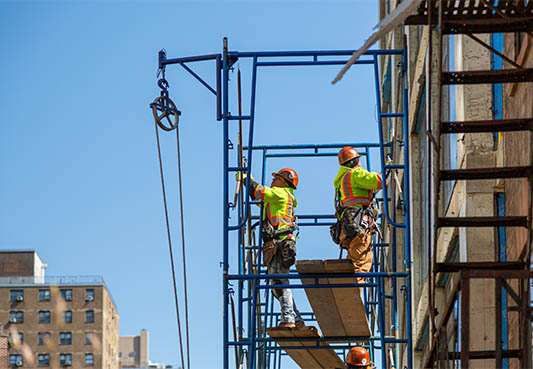New York Construction Report staff writer
New York remains one of five states that have not yet recovered construction jobs lost during the COVID-19 pandemic. According to a report from State Comptroller Thomas P. DiNapoli, the path to full recovery may be slow, especially in New York City, where the industry faces several challenges including weaker demand for office space.
Residential construction spending has bounced back since the pandemic, but nonresidential construction—such as offices and commercial buildings—remains below 2019 levels in New York City and is expected to stay low for some time.
“Several factors, many beyond the city’s control, will affect construction growth,” DiNapoli said. “Federal policies on tariffs and immigration may impact costs and the availability of workers. Still, the city can take steps to encourage development of infrastructure and buildings to support the local economy.”
In 2024, the greater New York City metro area—which includes Long Island, the lower Hudson Valley, and parts of northern New Jersey—had about 389,000 construction jobs, the highest of any metropolitan area in the U.S. This represents 4.4% of the nation’s construction workforce.
However, statewide construction employment is still 4% (around 16,300 jobs) below pre-pandemic levels. The biggest shortfall is in New York City, where construction jobs declined 11.3% (18,200 jobs) since 2019.
In 2024, New York City’s construction workforce totaled 143,100 jobs, down from a record 39.7% share of the state’s total in 2019 to 36.7%. Outside the city, construction employment slightly exceeded its 2019 level by 0.8%, adding about 1,900 jobs.
Nonresidential construction spending dropped sharply during the pandemic, falling 43% in 2020. Though it has grown for three straight years, it remains 3.4% (about $786 million) below 2019 levels as of 2023. Estimates show spending declined another 2.6% (roughly $572 million) in 2024 due to weak demand.
By contrast, residential construction spending fully recovered by 2023, rising 17.6% (about $3.4 billion) above 2019 to $22.8 billion, driven by strong housing demand and inflation. However, spending is estimated to have fallen 16% in 2024, partly because the 421-a tax abatement expired. New incentives such as the 485-x and 467-m programs, introduced in 2024, could help boost residential construction going forward.
Government construction spending also increased after an initial pandemic decline. It reached $23.3 billion in 2023, up 18.1% from 2019, and is projected to hit a record $28.1 billion in 2024. Still, the New York Building Congress warns that government capital spending may fall in 2025 and 2026 if federal funding is cut, potentially delaying major city and transit projects.
Labor remains a critical concern. In 2023, immigrants held 61% of construction jobs in New York City—much higher than elsewhere in the state or country. Federal immigration enforcement efforts risk disrupting projects and tightening the labor pool.
Staffing at the city’s Department of Buildings, which handles permits and inspections, has also fallen sharply. Between March 2021 and March 2025, construction-related staff dropped more than 21%, from 662 to 519 employees. This decline could slow building approvals and affect construction schedules.
The report highlights a complex mix of factors shaping the construction sector’s recovery in New York. While some areas have bounced back, others—especially in the city’s nonresidential market—face ongoing headwinds that could slow growth for years to come.DiNapoli’s report found:
- Construction spending in the city reached a record high of $68.2 billion in 2023, partly due to rising costs, exceeding the pre-pandemic peak in 2019 by 10%. The number of construction businesses decreased by 3%, or 479 firms, in 2024, the first annual decline since 2011.
- In 2024, construction was the fifth (out of 10) highest-paying employment sector in New York City, with an average salary of $95,800.
- The city’s construction sector accounted for $28.1 billion in economic activity in 2023, 3% higher than 2019. When adjusted for inflation, the construction share of the gross city product declined from 2.5% in 2019 to 1.8% in 2023 as other sectors, such as the information and professional and business services industries, took on significantly larger roles over the period.
- Around one-fifth of the jobs in the construction sector in New York state (20.7%) and the New York City metropolitan area (19%) were held by union members in 2024. Both shares were down significantly from 10 years ago (31.3% and 27.4% in 2014, respectively). For the five boroughs, the majority of construction workers are union members.
- The number of construction permits declined in 2023 and 2024, indicating that a return to pre-pandemic growth trends (4.5% annual average) has not yet occurred.










